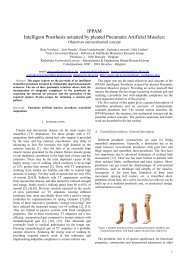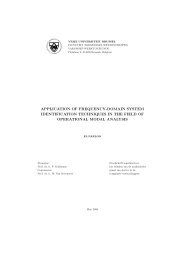VRIJE UNIVERSITEIT BRUSSEL Acoustics - the Dept. of ...
VRIJE UNIVERSITEIT BRUSSEL Acoustics - the Dept. of ...
VRIJE UNIVERSITEIT BRUSSEL Acoustics - the Dept. of ...
Create successful ePaper yourself
Turn your PDF publications into a flip-book with our unique Google optimized e-Paper software.
82 CHAPTER 5. SOUND INSULATION<strong>the</strong> transmission <strong>of</strong> <strong>the</strong> sound (and vibrations) energy from one room to <strong>the</strong>o<strong>the</strong>r. This indirect way <strong>of</strong> transmission throughall those o<strong>the</strong>r boundaries /paths (o<strong>the</strong>r than directly through <strong>the</strong> partition which separates <strong>the</strong> rooms)is called ’flanking’ transmission (see Figure 5.1). Consequently a distinctionmustbemadebetween<strong>the</strong>soundinsulationR<strong>of</strong>aseparatingstructurewhichis called <strong>the</strong> ’sound reduction index’ in <strong>the</strong> international ISO140 norm, and<strong>the</strong>soundinsulation D n between two roomswhich iscalled ’<strong>the</strong> normalizedlevel difference’ in <strong>the</strong> ISO140 norm.Figure 5.1: Flanking (2 to 4) and direct (1) transmission.It is obvious that in practice, i.e. in <strong>the</strong> acoustics <strong>of</strong> a construction,only <strong>the</strong> sound insulation D n between two rooms matters because flankingtransmission is always present. Normally we will perform <strong>the</strong> so-called ’fieldmeasurements’ <strong>of</strong> <strong>the</strong> insulation between two given rooms, where we ignore<strong>the</strong>soundpathbetween<strong>the</strong>source-andreceivingroom. ThesoundinsulationD n is expressed in dB. To characterize <strong>the</strong> quality <strong>of</strong> a partition constructionby measurements all <strong>the</strong> flanking effects must be eliminated and thus a fieldmeasurement is not an option. A ’laboratory-only measurement’ must beperformed (see Figure 5.2) Such a laboratory consists <strong>of</strong> two rooms : <strong>the</strong>source- and receiving room are independent with regard to vibrations, and<strong>the</strong> sound transmission occurs only through <strong>the</strong> structure under test. Thisenables us to determine <strong>the</strong> sound insulation R (this is typically larger thanD n ).We will now give <strong>the</strong> formula that enables us to experimentally determine<strong>the</strong> sound insulation as function <strong>of</strong> <strong>the</strong> frequency. Let S represent <strong>the</strong>separation plane consisting <strong>of</strong> <strong>the</strong> wall to be tested (10 m 2 is required for
















